What Are the 27 Winning Projects at ‘IoT2Wild Contest 2022’?!
By Ye Seong SHIN 3 years agoOn October 11th, winners of Seeed’s ‘IoT2Wild Contest 2022’ were announced at Hackster’s Impact Summit online. With the judges’ evaluations and discussions, 31 winners have been selected as final winners for 6 types of Awards. Find out the winners’ projects in detail!
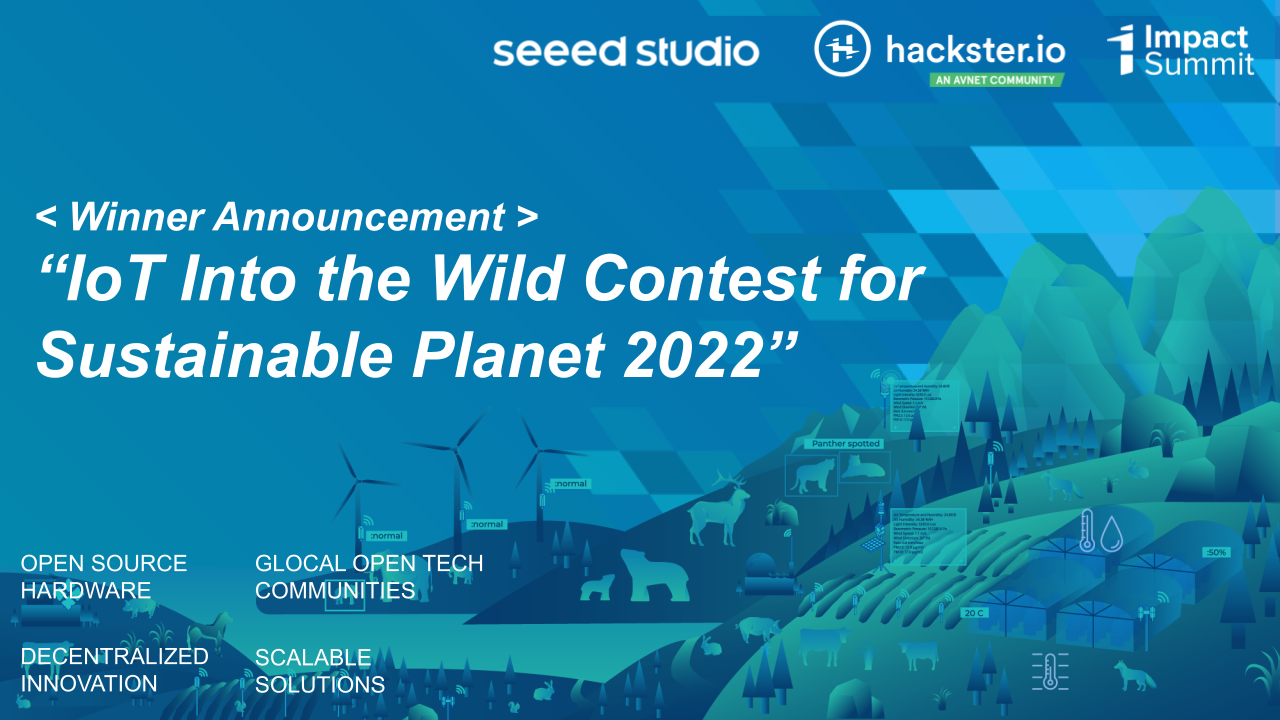
Dear Community,
As you know, Seeed’s “IoT Into the Wild Contest for Sustainable Planet 2022” (aka ‘IoT2Wild Contest’) was hosted on Hackster for about 4 months from June through September this year. And as a result of this Contest, we received 122 Project Submissions, awarded 104 free hardware kits, and inspired 561 Participants from 78 Countries in 6 continents. On October 11th, winners of the IoT2Wild Contest were announced online at Hackster’s Impact Summit 2022. As a result, 31 winners have been selected as final winners for 6 types of Awards.
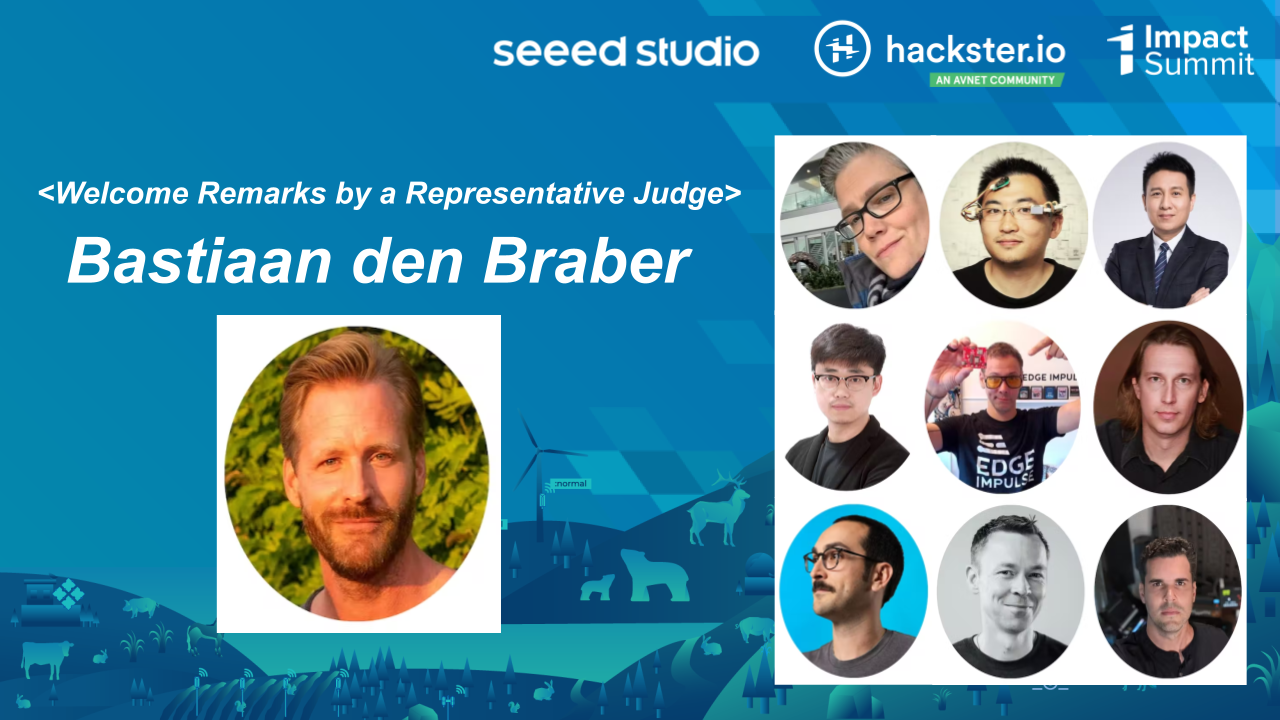
As Bastiaan den Braber, the Founder of Zambezi Partners, rightfully shared in the winner announcement:
“The objective of this contest was to show us the power of AI, IoT, and Edge Computing for saving the Earth and biodiversity. … We have been truly impressed with the breadth of solutions submitted covering all aspects of planetary threats! … Submissions covered everything from precision farming, insect- and algae based protein production, early detection of wildfires, harmful algae, and severe weather, to monitoring volcanoes/oceans/skies/crops, to acoustic monitoring of protected areas, to tracking endangered wildlife species. You name it, and numerous amazing solutions were submitted.”
Now, without further due, let’s find out the winners and their sustainability projects!
1. Excellent Sustainable and Scalable Project Award x 1 Winner
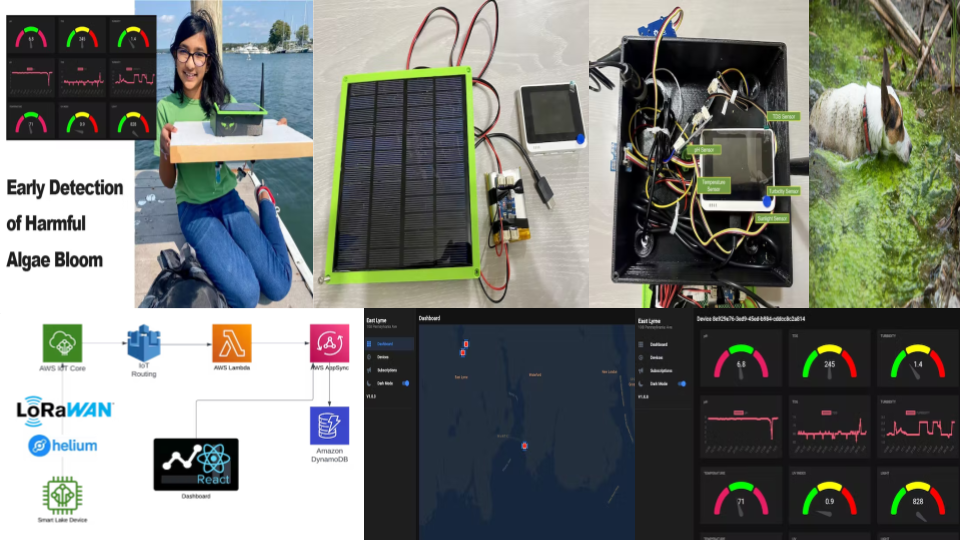

“Something very tragic happened recently in our town. A dog parent took her dog to a lake for a swim. She did not notice there were algal blooms. On the way back home, the dog started panting, [and then she] was taken to emergency immediately, but could not survive. 
– Mithun Das, Sashrika Das
Algae is the foundation of life on land and aquatic ecosystems, and the producer of 50% of the oxygen on the Earth. However, due to the increased high levels of nitrogen and phosphorus in the water body, algae has been over-proliferating recently, and harmful algal blooms have been triggered. Since algae blooms produce harmful toxins that are detrimental to human and animal health, early detection of harmful algae blooms is necessary to prevent accidental contacts with humans and animals. This project used Wio Terminal and a variety of Grove sensors (PH level, turbidity, temperature sensors) to transmit the collected environmental data of algae blooms to the AWS cloud through Helium Network. Simultaneously, the prototyped device runs a tinyML model to monitor real-time conditions of algae blooms in water bodies (either ‘normal’ or ‘hazardous’). Thereby, residents living in the nearby areas can receive both real-time and chronological data for conducting predictive environmental analysis and taking preventative measures.
2. Innovative and Creative Project Award x 5 Winners
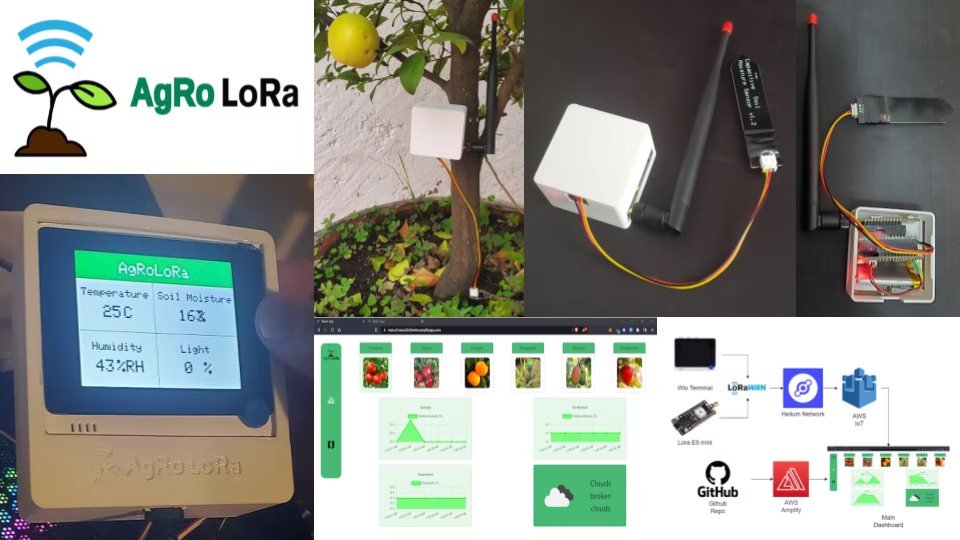

“If we want to have the most impact with a project regarding sustainability, namely, water sustainability, we have to focus on the industry that requires more of it, which is ‘agriculture’. … Most countries have their periods of drought, but as years become even hotter because of climate change, drought greatly affects several regions. California is an example of this. … Industry 4.0 tools and automation are greatly needed.”
– EdOliver, Victor Altamirano
Local and urban farming is increasingly gaining spotlights as an alternative agriculture technique to move forward towards sustainable food supply chains, fulfill the growing population’s nutrition needs, and keep up with global trends on favoring organic food produce. However, adoption rate of IoT and other Industry 4.0 technologies remains lower than what is desired, due to many constraints. Therefore, local and urban farming should be upgraded with a cheap and readily available technological solution, for it to be sustainable. On this background, this project’s prototype is an automated irrigation and crop health monitoring device for local and urban farming, which is developed on the basis of SenseCAP K1100 Kit, while performing predictive analytics via the Helium network.
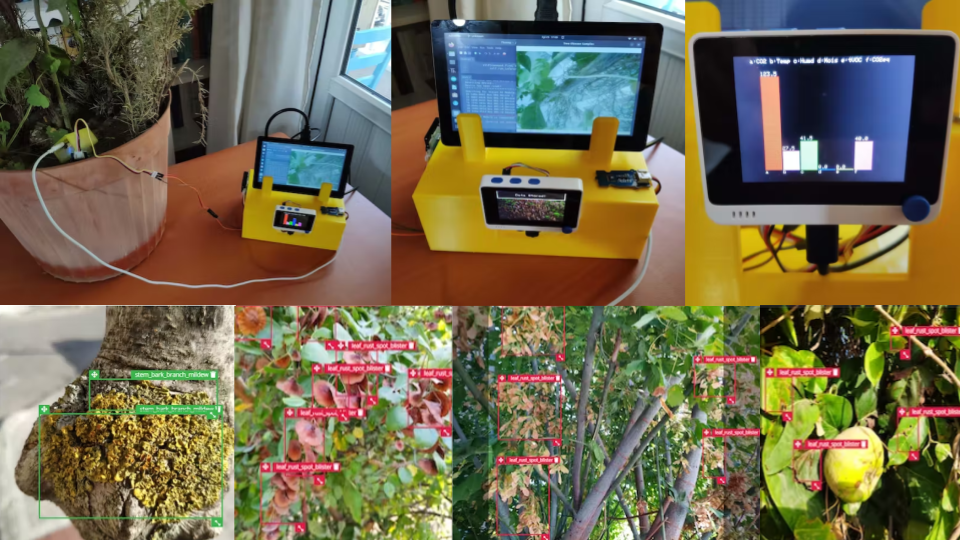

“Since trees are crucial for pollination, spreading tree diseases can cause crop yield loss, animal deaths, widespread infectious epidemics, and even land degradation due to soil erosion. Therefore, it is important to detect tree diseases before they permeate into the forests. … It is also important to check … environmental factors to achieve better detection results. In this regard, by getting prescient warnings regarding potential tree diseases and environmental factors, we can take necessary precautions to avoid hazardous outcomes related to forest degradation and crop yield loss.”
– Kutluhan Aktar
Due to climate change and excessive deforestation, trees and plants have become more susceptible to infectious diseases. Therefore, the project uses the SenseCAP K1100 Kit, Wio Terminal, and Grove sensors (CO2, temperature, humidity sensors) to collect data from trees infected with different types of plant diseases, and then uses Edge Impulse to train the object detection model with machine learning, and finally, receives the detection results and early warning notifications through MMS.
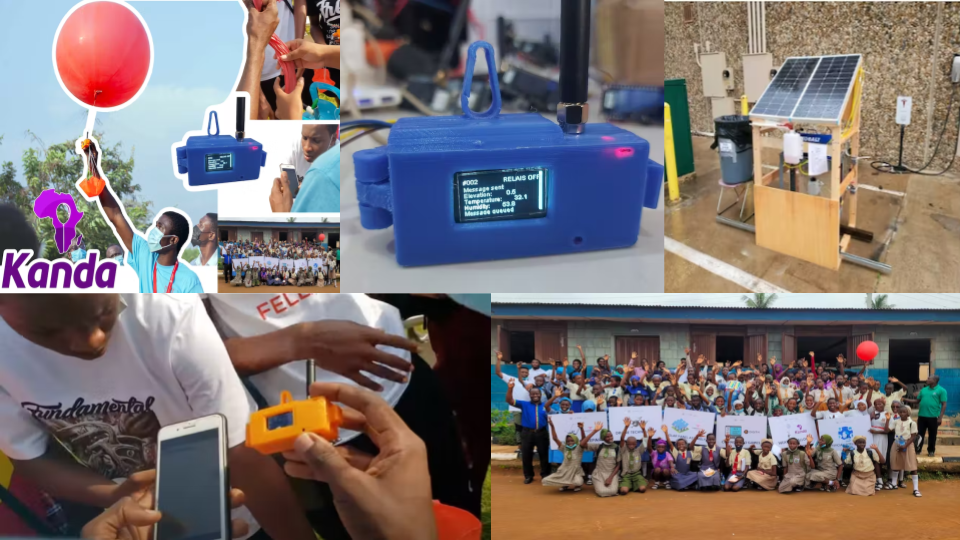

“For two years I worked at NASA Goddard Space Flight Center on the GOES-16 weather satellite, and then left NASA in 2019 to explore blockchain and IoT technologies independently. I immediately recognized the low-power, long-range potential of LoRaWAN to solve one of the most intractable field efforts in the climate science community. … LoRaWAN … performs best in line-of-sight situations. It is very suitable for outdoor sensors and indoor monitors that only require sending small amounts of data at a time.”
– Nicolas Lopez
Monitoring upper-level-atmospheric data in West and Central Africa plays a significant role in weather and climate forecasting. It can help local people to make better, informed decisions and predictions about extreme natural disasters, such as floods, droughts, heavy rainfalls, and can even be used to improve the forecasting of Atlantic hurricanes in the 7 to 14 day timeframe. On this backdrop, this project aimed to measure meteorological data 32,000 feet above West Africa, using a Grove sensor (air temperature, humidity, barometer sensor). Helium’s LoRaWAN network was used to transfer the collected environmental data, after which Node-RED (no-coding platform) was used to process weather observations and authentication checks. To make the weather balloon float, Nicolas Lopez and students developed a method of inflating the balloons with locally-produced, inexpensive hydrogen instead of expensive helium. To date, Nicolas Lopez has completed 25 launches of weather balloons with students from 5 locations in Africa and the USA.
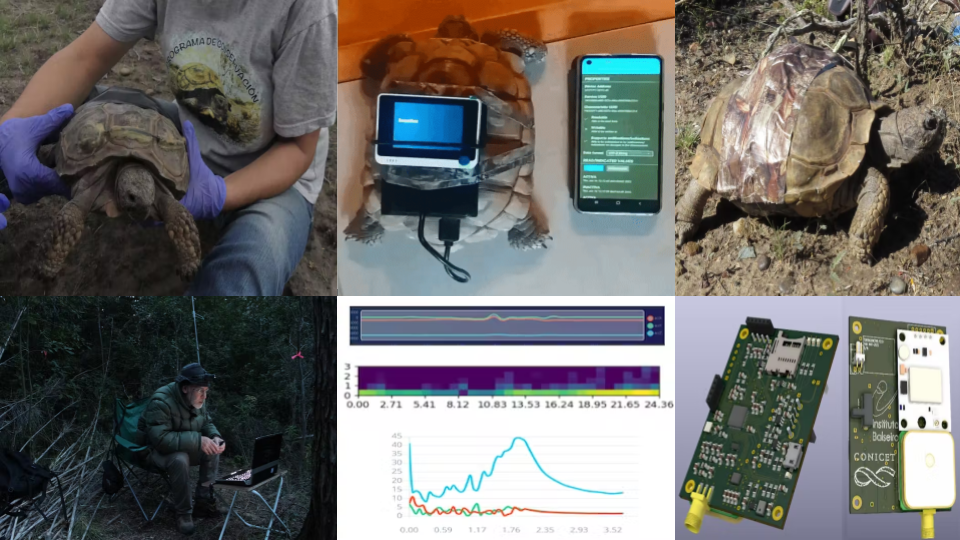

“We are a group made up of biologists, physicists and engineers. We have been working interdisciplinarily for 5 years with different animal species, different habitats and challenges. We carry out our research at the Bariloche Atomic Center, San Carlos de Bariloche, Río Negro, Argentina. … We started by monitoring the marsupial, Dromiciops gliroides, in its natural habitat. This work turned out to be more than challenging given that this animal lives in the forest where there is no GPS signal, it weighs approximately 20 grams, and it is a nocturnal animal. We developed our own antennas to set up receiving stations and placed transmitters on individuals of D. gliroides. Our project continued to grow, and many ecology groups approached us asking if we could develop any monitoring systems that could be adapted to their context. … Now, with SenseCAP K1100 [Kit], we could put together a connected network of devices that simultaneously monitor animals. … Knowing how animals move, surveying their trajectories, finding their nests, studying how their behavior depends on external variables (such as temperature or wind, for example) are key to establishing guidelines that help their conservation.”
– Laila Kazimierski et al.
This project aims to answer multifold questions about the basic biology of endangered wildlife species, in this case, a tortoise (Chelonoidis chilensis, marked as one of the vulnerable animals according to IUCN 2014) – very little is known about its biology. Thereby, by using Wio Terminal and Grove – Long Range 868MHz together with Arduino IDE, they were able to design and develop a prototype device that can be effectively used for field monitoring scenarios in mapping out and monitoring the animal’s movement patterns, trajectories, nests, and natural environmental habitats in real-time.
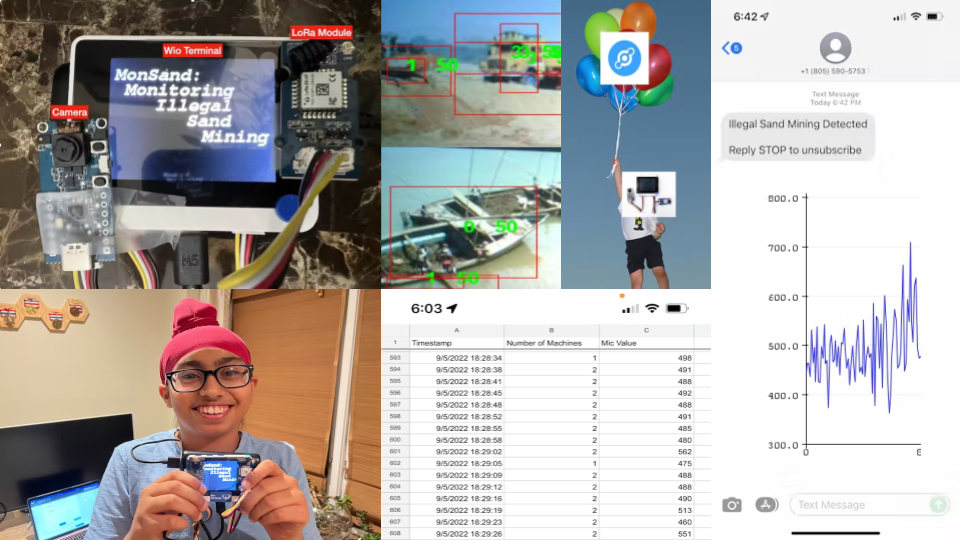

“Sand is used in numerous applications such as construction (for cement), and microchips (for silicon). But the problem is that as the uses of this material are increasing, the supply is greatly decreasing. … Normal desert sand is smooth and round and doesn’t bind together. This means that it can’t be utilized in the production of glass used in the windshield of cars or the screens of our phones. Instead, we have to use river sand (wet sand) which is angular and easily sticks together. We are running out of ways to legally mine wet sand without disturbing the coastline. So. in many third world countries, sand is being supplied to industry through illegal ways that are harmful to the environment.”
– Raunak Singh
The project is about monitoring and detecting illegal sand mining activities at various water bodies, especially in the oceans and river banks. By using Wio Terminal, SenseCAP K1100 Kit, and Grove Lora E5, ‘MonSand’ device is able to capture the environmental and surrounding data of illegal sand mining sites, after which the collected data is sent to Helium Console, and then the monitoring outcomes and outcome analysis will be directly shown on Google Sheets. Furthermore, when certain illegal activities are detected, SNS will be sent to relevant authorities, either government agencies or NGOs, to go to the sites in concern and tackle the problems on-site, in real-time.
3. Enthusiastic Project Award x 10 Winners
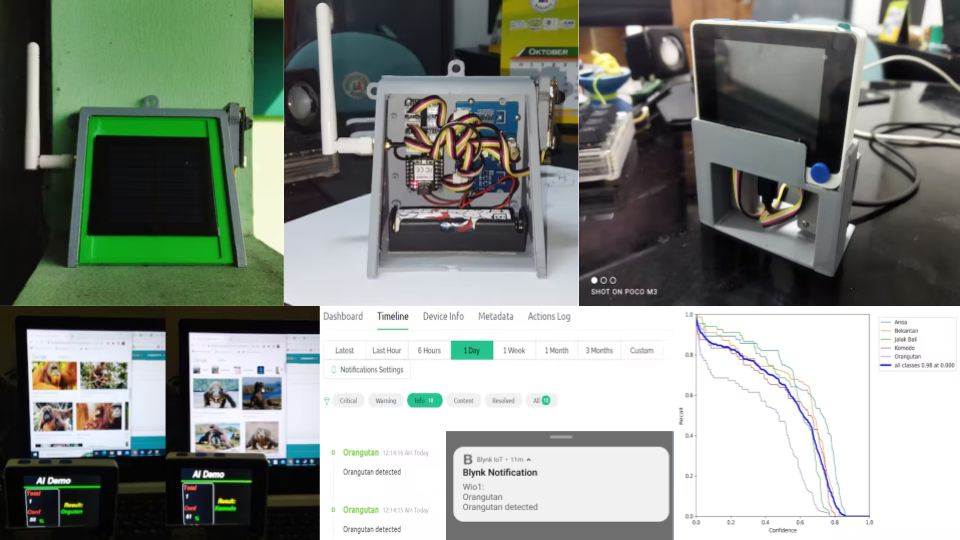

“Indonesia is home to the third-largest tropical forest after the Amazon and Congo. Some of these forests have biodiversity values and are also used as a sanctuary to protect rare animals that are endemic in Indonesia. … Conservation doesn’t run well in the forests of Indonesia due to various things. … Javan Rhinoceros is one of the animals that are still concerned to become extinct and still preserved until this day in Ujung Kulon National Park sanctuary. The Javan Rhinoceros is different from other rhinoceros because they only have one horn, and the horn is believed to have medicinal content. Because of that reason, there are still some people who do illegal hunting. … Another animal that is constantly hunted is the orangutan. According to various article sources, more than 100,000 orangutans have been killed in the past 20 years due to illegal trading and deforestation. … The main challenge in conservation according to the article is lack of staff or resources to protect the forests: only 1 staff is responsible for 7,000 acre of forest. Another challenge for conservation is wildfire. … I want to build a device that helps conservation to monitor the forests’ conditions and detect the endangered animals.”
– Hendra Kusumah
This project focused on harnessing audio classification to check the endangered wildlife’s liveliness, using object detection to check the wildlife activities, notifying illegal poaching activities in real-time, and triggering early warnings on wildfire detection to prevent the spread of wildfires. Through embedding SenseCAP K1100 Kit, Seeed Studio XIAO RP2040, and Edge Impulse Studio, the prototype device achieved long-distance, wireless transmissions of data outcomes to be appeared on computer dashboards and smartphone messages.
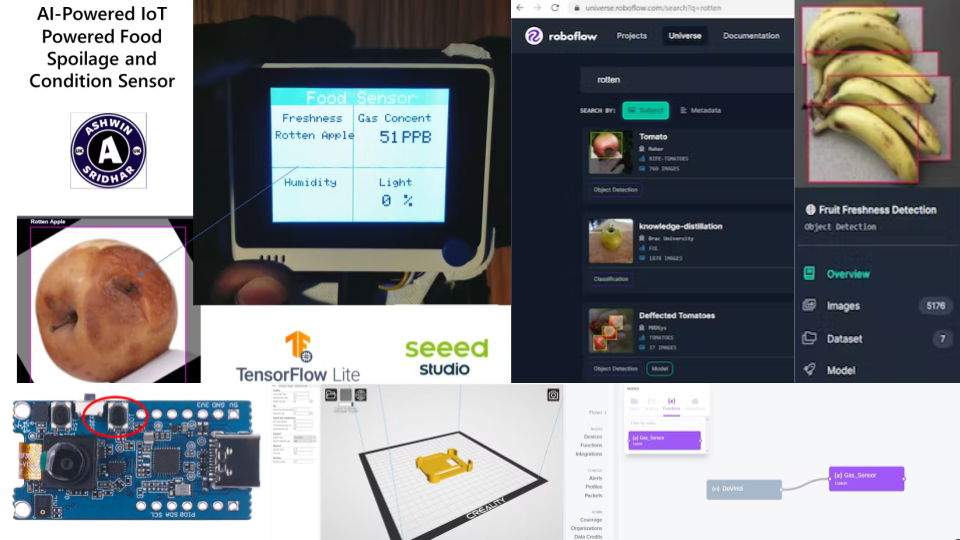

“Food waste across the agriculture sector is an increasingly growing contributor to greenhouse emissions. … Food waste occurs due to pests and storage conditions, with many farmers, pack houses and exporters throwing away yield due to appearance and fears of spoilage. Current methods of determining spoilage remain qualitative, but the detection of released gases and computer vision provides a more effective solution. A low-cost solution is required which not only improves food preservation but can also detect food spoilage to assure food quality.”
– Ashwin Sridhar
The project is about a smart IoT powered device, which can be used to monitor food storage conditions and determine food spoilage at an early stage, that is based on AI-based image detection method through using SenseCAP K1100 Kit, Wio Terminal, Grove – AI Vision Sensor, and TensorFlow. Different types of food will emit various types of gas based on their core composition elements. For example, rotting meats will release ammonia (NH3) and hydrogen sulfide (H2S), whereas fruits and vegetables will produce ethylene (C2H4). Therefore, detection of the composition of the surrounding air quality around different food types can help farmers, suppliers, supermarkets, and households to more accurately determine the progress and extent of food rotting procedure, not to mention edibility of food.
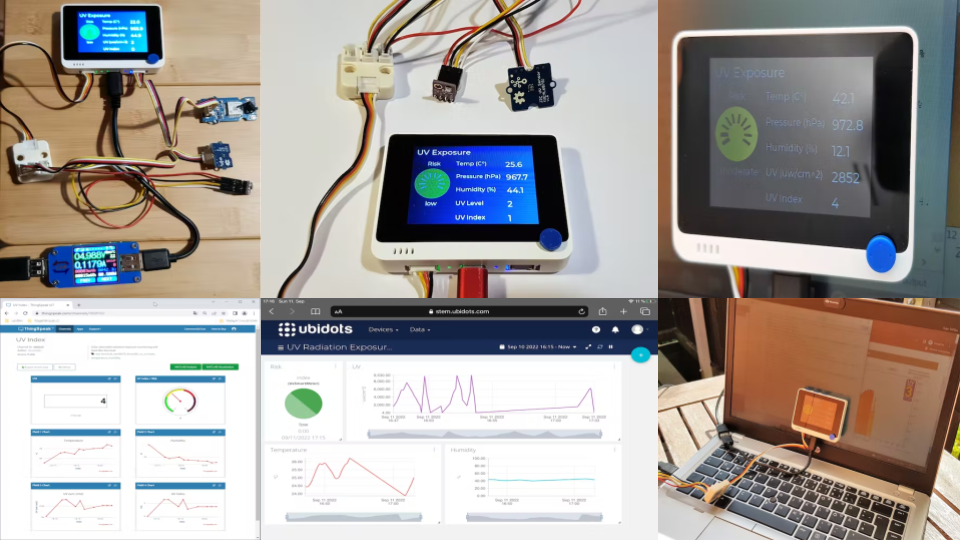

“UV-related diseases, especially skin cancer, are causing problems on public well-being around the world, as well as resulting in high and increasing healthcare costs. Ozone depletion and climate change are aggravating this situation.”
– dxcfl
The project implemented an UV radiation exposure monitoring device to help prevent possible skin diseases through sending out preventative warning messages on the detected UV exposure levels. By using Wio Terminal, Grove – Wio-E5, Grove – I2C Hub, Grove – I2C UV light Sensor, Helium Console, and Ubidots, it functions as a remote sensor unit, as well as a personal dosimeter to continuously measure the UV index and other environmental parameters like air humidity and temperature, which also may enhance the harmful effects of UV radiation. Moreover, the device can calculate the actual individual risks in a specific monitored area. As a result, collected environmental data will be uploaded on an IoT cloud platform via Wifi or LoRaWan, so that the data can be used to tailorize warning messages for preventive actions (ex. applying sunscreen, wearing protective clothes, limiting sun exposure time).
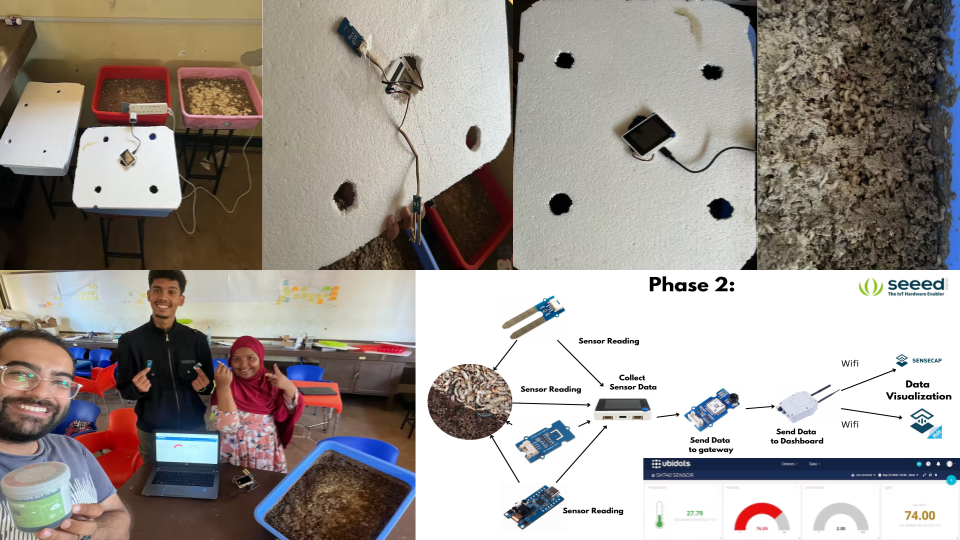

“Of the feeds currently fed to chickens, pigs and farmed fish, they all require high levels of protein. At the moment that protein comes from soy or fish meal. The inputs to produce both of these consume natural resources and are being consumed at an unsustainable rate. … Black soldier fly (BSF) is an insect native to Africa that as a larvae can consume as much as 70% of its own body weight in waste every day. For every kilogram of organic waste it consumes, 50 grams of protein are produced. We use the larvae of this fly to recycle nutrients in food waste and become the protein content for chicken or fish feed.”
– Team Tanzania Open Innovation
The project sheds light on cultivating BSF farming as an alternative, sustainable, and accessible protein content production method to complement animal feed. Using the SenseCAP K1100 Kit, the main environmental parameters that are monitored in real-time include air temperature and humidity, soil moisture and temperature, as well as light intensity. Considering the potential of widespread BSF farming in Africa to replace 60 million tons of traditional feed production and fertilizers, it is estimated that 15 million jobs will be created, 86 million tons of CO2 emissions can be prevented, and a market value of crude protein can be increased up to US$ 2.6 billion.
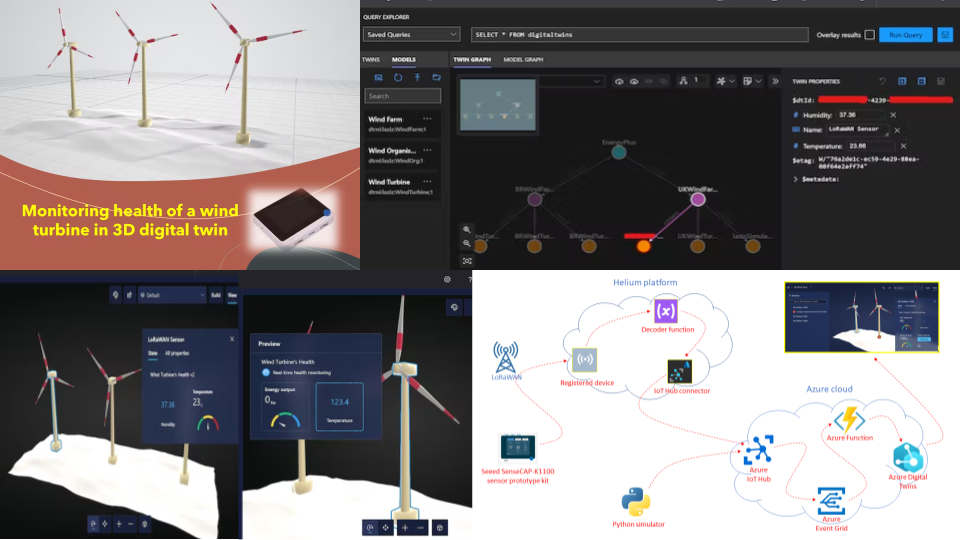

“Wind farms are great contributors to our sustainability agenda as generators of green renewable energy. They are typically located in some remote onshore/offshore locations, which makes it crucial to monitor their health and provide timely support.”
– Laziz Turakulov
This project emphasized the importance of monitoring the health of wind turbines in remote locations, so as to detect optimal time and periods of maintenance by using Wio Terminal, SenseCAP K1100 Kit, Helium Console, and Microsoft Azure.
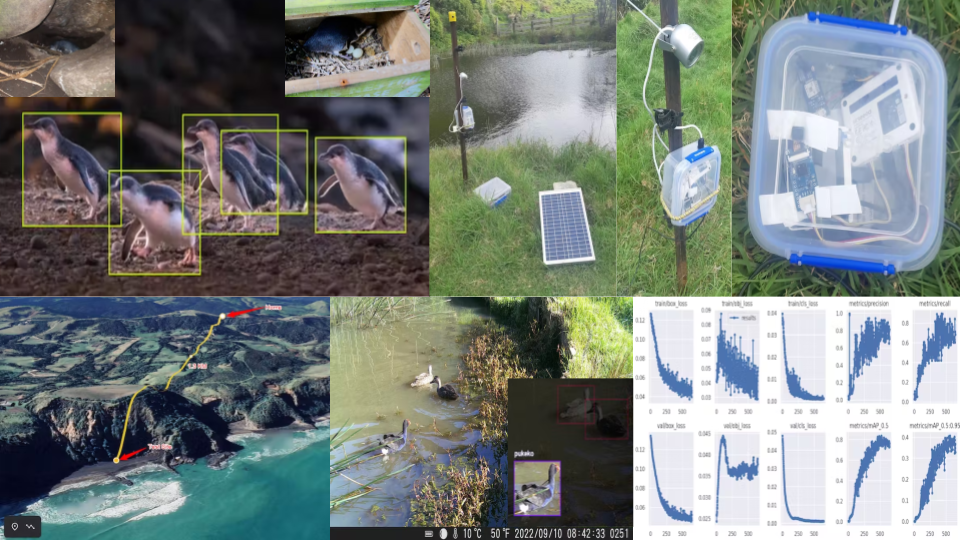

“Discarded nets, marine plastic pollution. Sea temperature rise, marine heatwaves. Coastal erosion and inundation destroy nesting habitat. Predation by feral cats, dogs, mustelids and rats. Things are pretty dire for the Little Blue Penguin (kororā in Maori). … New Zealand’s Department of Conservation categorizes kororā as ‘declining/at risk”. … present throughout New Zealand and in the south and south east of Australia.”
– Richard Wright
This project is concentrated on building an AI object detection system to identify, count, monitor, and protect Little Blue Penguins when they come ashore and go to the sea, through LoRaWAN, Wio Terminal, Grove AI Vision Sensor, among a few. In this way, a series of low-cost cameras with long battery life can detect predator animals, help alert penguin protection groups to take necessary actions in preventing wildlife-human conflicts, as well as provide education to local communities about their presence and the need to protect them. Last but not least, monitoring the penguins’ quantity ashore at a longer term and over a greater geographic area could contribute to the wildlife population studies, as an effort to facilitate improvements in the protection of such species.
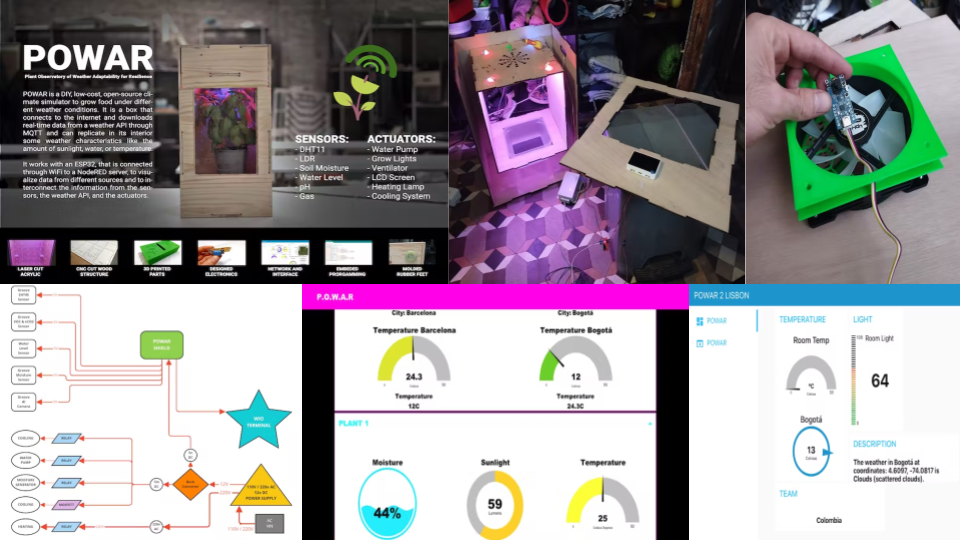

“Climate change-related crises, such as floods or drought, affect the lives and livelihoods of millions of people, exacerbating poverty, hunger and social tensions. POWAR helps communities and governments understand these growing risks and take specific action to manage the impact of climate crises on food security.”
– Pablo Zuloaga Betancourt
POWAR, the Plant Observatory of Weather Adaptability for Resilience, is a DIY, low-cost, climate simulator to grow food produce in a more extreme future weather. Based on Wio Terminal and SenseCAP K1100 Kit, POWAR seeks to empower smallholder farmers on how climate change may affect what they grow today, and facilitate them to become more resilient farmers to future weather patterns. The more people use POWAR in different parts of the world, the more experiments there will be on different crops and climates. Thereby, an open knowledge database could be created to feed an AI model to draw predictions about the best ways to grow different types of food produce in extreme weathers.
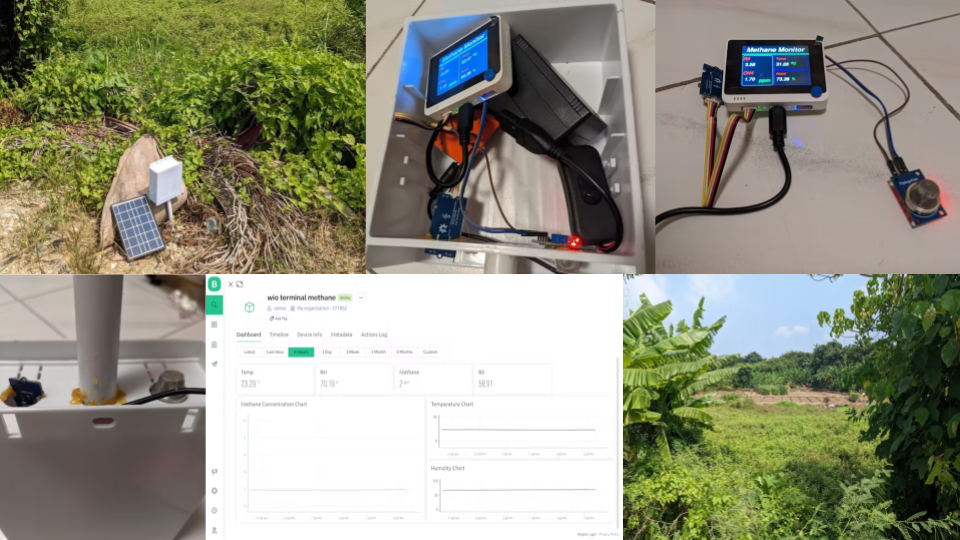

“Paddy field is one of the major sources of greenhouse gases (both CH4 methane and NOx nitrogen oxides) according to some research, however, some recent research suggests that there are miscalculations. To find out, I built an easily deployed CH4 monitor to help rice farmers or other interested citizen scientists to look into this issue. Because rice is the main source of food for most Asian countries, it is important that we acknowledge the problem accurately and respond accordingly.”
– JAmes Woods
The project prototype serves as an entry-level kit for interested farmers and citizen scientists to start monitoring the concentration of methane in their surrounding environment, so as to collect and analyze the data to study different environmental parameters on the emission of GHGs. The project employed Wio Terminal, Grove – I2C High Accuracy Temp&Humi Sensor, and Blynk.
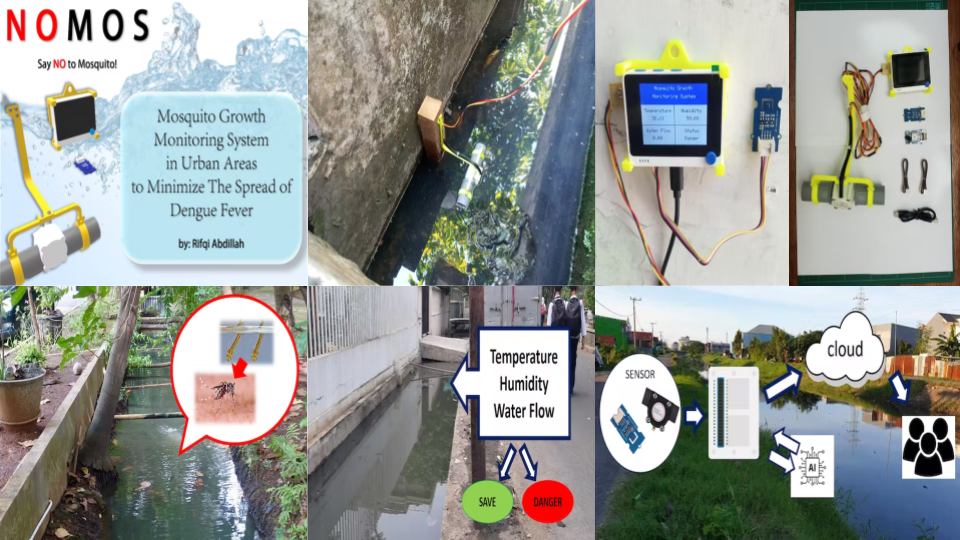

“In urban areas, especially in Indonesia, sewer lines are generally located at the front of the house. This channel will drain the remaining water from each house to a landfill. In some ditches, some obstacles cause water not to flow correctly, coupled with the tropical season in Indonesia, making these conditions an optimal place for mosquitoes to breed. Before this causes a worse impact, some treatments are needed to overcome this.”
– Rifqi Abdillah
NOMOS – which stands for ‘NO MOSquitoes’ – is a mosquito growth monitoring system based on temperature, humidity, and water flow that can be implemented in local sewage systems to minimize the spread of dengue fever. NOMOS will monitor the water flow to check if the water flow is running normally or not. Warm temperatures will also be one of the indicators to determine whether the condition of the sewer is an optimal place for mosquitoes to breed. All data collected from relevant sensors of SenseCAP K1100 Kit will be sent to the database. Then, the system provides notifications to users. Moreover, the use of tinyML on Edge Impulse platform can be used to predict the level of dangers that may arise.
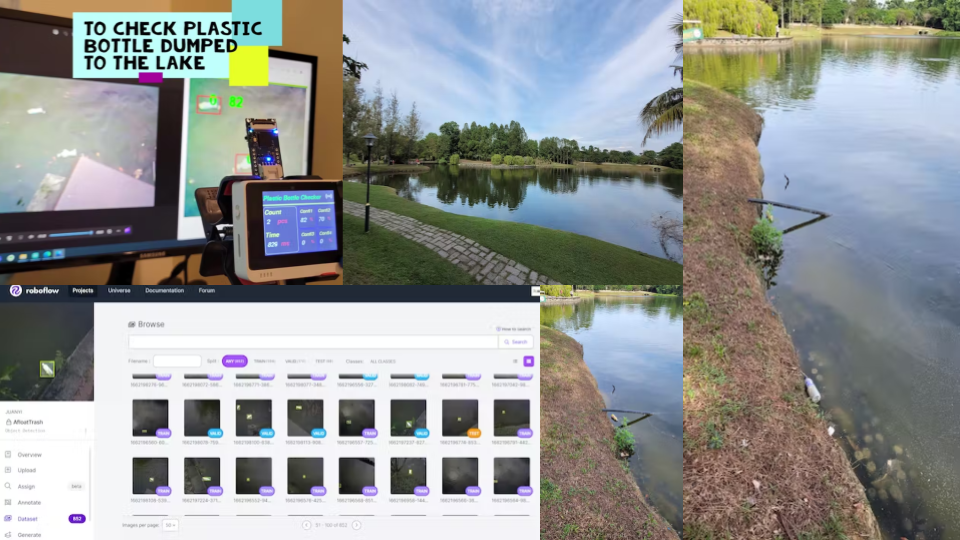

“Many people thought plastic bottle/containers are something that will be “digested” (degradable) by our mother nature and just discard them to river/drain/lake/ocean at their convenience. My project is inspired by the famous carton character WALL-E, which is a robot designed to clean up the trash on Earth. It’s a good movie that highlight how serious it can be if human being continue dumping trash to mother nature, one day we will need WALL-E to clean up our mess.”
– JuanYi
The project is about using the AI vision to detect plastic bottles floating on lake surfaces and send the collected data to the cloud for easy configuration and real-time/chronological analysis. The project is developed using the SenseCAP K1100 kit provided by Seeed Studio, with only 3 parts to be used: Wio Terminal the controller with TFT display; Grove-Vision AI Sensor, to run inference for object detection, and; Grove-LoRa E5, to send data by connecting to Helium. In the future, the project is sought to be upgraded with a mechanism to retrieve the detected plastic bottles and other plastic wastes from the lake.
4. Best Helium Award x 1 Winner


* Please refer to the project explanation from “2. Innovative and Creative Project Award” section.
5. Helium Award x 10 Winners
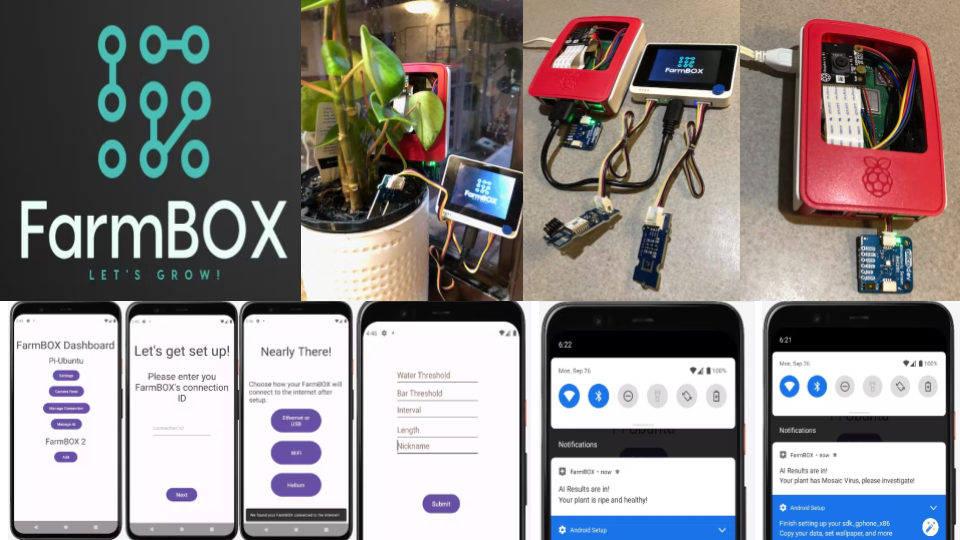

“FarmBOX empowers students in schools to learn about a whole variety of technologies including Helium and LoRaWAN.”
– Team FarmBOX
FarmBOX is an IoT device designed to enable AIoT-powered sustainable monitoring of plant cultivation, built on the basis of SenseCAP K1100 Kit and Wio Terminal. It can be automatically adjusted to plant and irrigate plants on the basis of various sensor data analyses. For instance, it can irrigate more water in case the soil and air temperature indicates a certain amount of temperature range. Having a Grove – AI Vision Sensor allows real-time monitoring of plants and crops to minimize the frequency of site visits in-person, monitoring and sending alerts on plant ripeness, status of plant health and diseases, and the like.
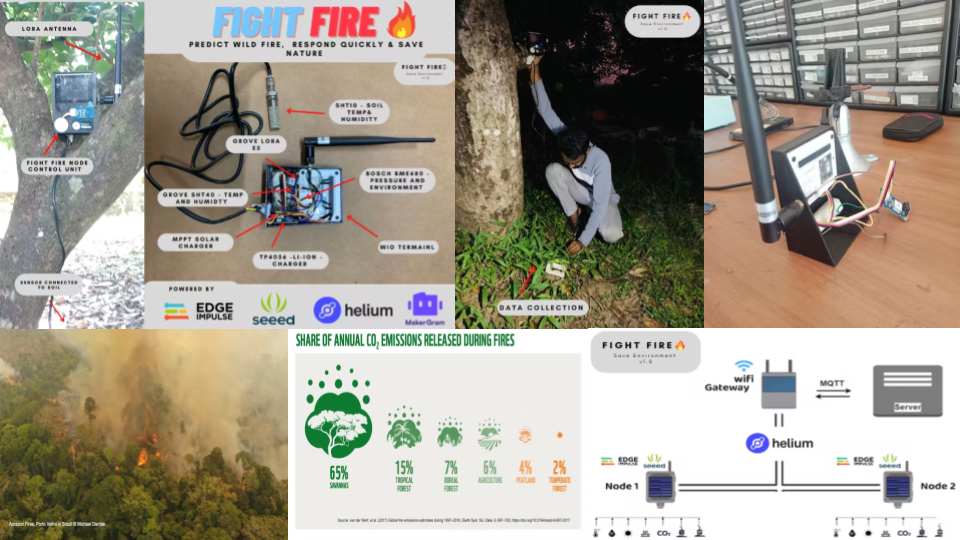



“Wildfires affect all biomes, from forests and savannas to grasslands and tundra. … In April 2020, the number of fire alerts across the globe was up by 13% compared to the previous year – which was already a record year for fires. Persistent hotter and drier weather due to climate change, and other human factors such as land conversion for agriculture and poor forest management are the main drivers behind the increase. It is estimated that humans are responsible for around 75% of all wildfires.”
– MUHAMMED ZAIN & Salman Faris
Fight Fire is a wildfire prediction device that can help firefighting authorities to respond quickly to the wildfire instantly at an early stage, as well as to identify the presence of humans and wildlife species in the hazardous area of concern. Made on the basis of Wio Terminal, Grove – Temperature & Humidity Sensor, Grove – LoRa E5, Helium’s LoRaWAN Hospot, Edge Impulse Studio, and Node-RED, the device will be monitoring weather conditions of the forest using various sensors and recordings of dramatic increases in atmospheric temperatures, decreases in soil moisture levels, and changes in barometric pressures.


* Please refer to the project explanation from “3. Enthusiastic Project Award” section.


* Please refer to the project explanation from “2. Innovative and Creative Project Award” section.


* Please refer to the project explanation from “3. Enthusiastic Project Award” section.


* Please refer to the project explanation from “3. Enthusiastic Project Award” section.
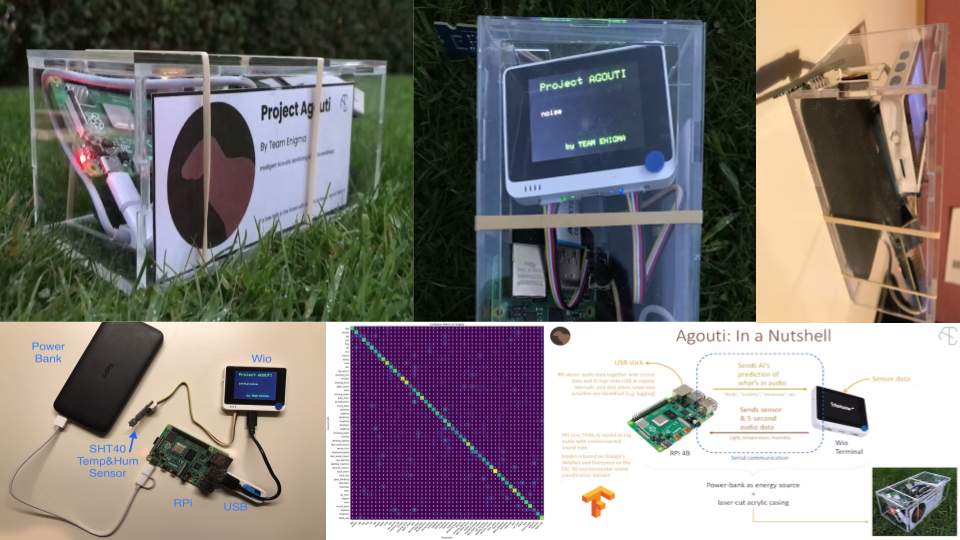

“Traditional vision-based wildlife monitoring methods are limited by weather conditions, the camera’s field of view, the size of target organisms, and their proximity. There is great room for alternative technologies which can monitor wildlife more reliably through other channels: like acoustic monitoring.”
– Team Enigma
Project Agouti is an intelligent, weatherproof acoustic monitoring device that can be easily deployed in the wild to record and analyze wildlife species’ audio data. The project deployed Edge ML to automatically classify the audio data into classes like insect sounds, bird chirping sounds, human activities (ex. vehicle and talking sounds), and logging (ex. chainsaw noises). At the same time, environmental data – like temperature, humidity, and light – are recorded to link with the audio classifications, so as to quantify how exactly the environmental conditions influence various species’ behaviors.
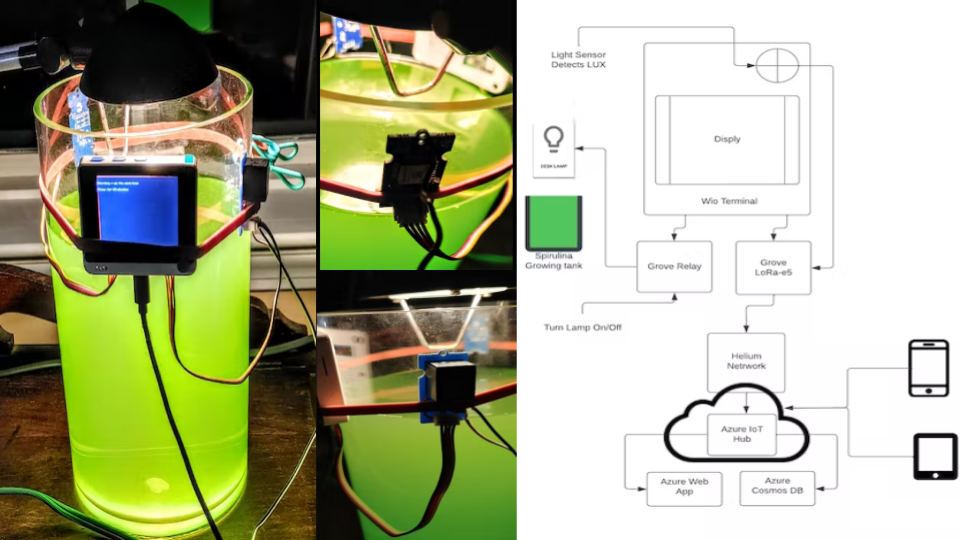

“Spirulina Algae is a superfood with all the nutrition value to sustain human beings.”
– skruglewicz
The project is mainly focused on remotely monitoring Spirulina Algae’s growth by creating an ideal environment for its cultivation with Wio Terminal, Grove – E5 LoRa Module and other Grove sensors in SenseCAP K1100 Kit, Helium Network, and SenseCraft v0.2. Environmental elements like water temperature, oxidation level, PH, amount of light exposure, enclosure environment, status quo of the growth can be monitored and reported. This system is portable enough to operate anywhere in the world where there is a LoRaWAN connection. By adopting a Machine Learning model, Spirulina Algae can be produced more efficiently, using the minimized amount of natural resources.
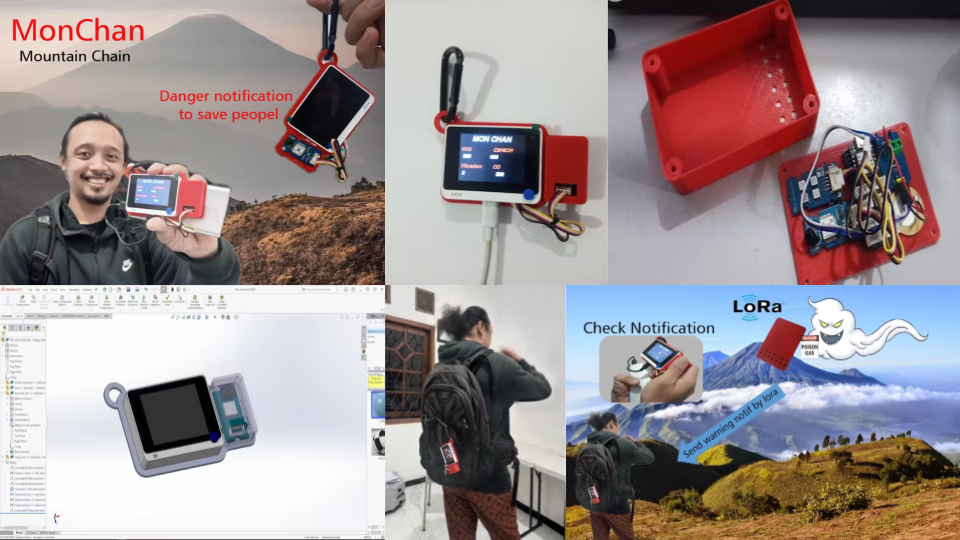

“Indonesia is a country located on the Ring of Fire, which causes a lot of volcanism to occur. The number of volcanic mountains that are still active in Indonesia makes it necessary to be aware of volcanic eruptions. … [Because of] The lack of information about the conditions at the top of the mountain, which includes some dangerous toxic gas activity and potential volcanic eruptions, climbers do not to know the actual conditions at the peak, so they cannot decide whether the climb is continued or not.”
– Tri Susanto
By utilizing LoraWAN for long-distance communication, the project prototype is a device that can monitor the accurate conditions of mountain tops with risks of volcanic eruptions. The device will capture various gas data that can be dangerous to climbers and nearby residents. After detecting such risks, the device will instantly send a signal to the device that climbers or residents have with them. This device was developed using Wio Terminal, SenseCAP K1100 Kit, Seeed Studio XIAO SAMD21, and Seeed Studio XIAO Expansion Board.
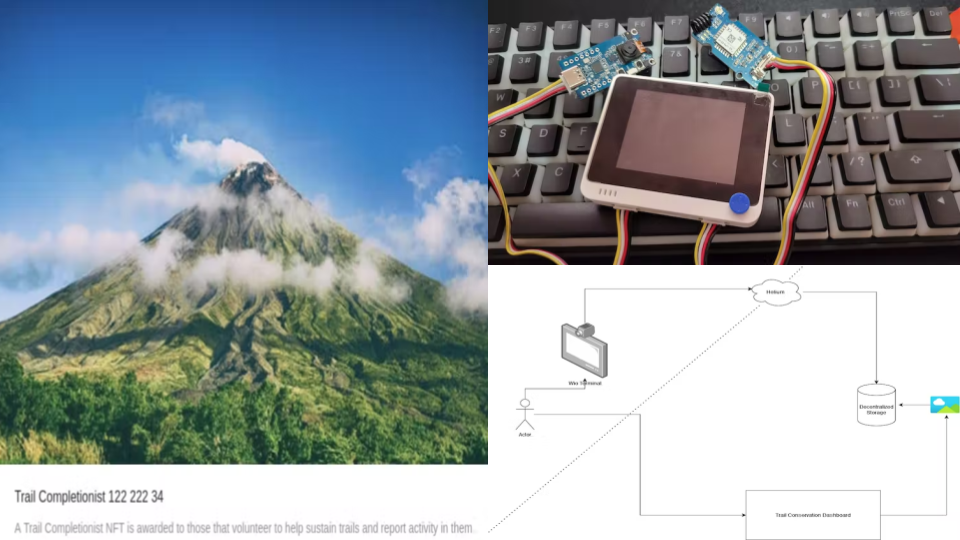

“Hiking is really fun, but sometimes hiking trails are used so often that the local ecosystem can be put at risk.”
– MD R. Islam
The goal was this project was to make a reward system for hikers for reporting the status quo of trail conditions in addition to collecting various environmental sensor information about the trail tracks with Wio Terminal deployed in various hiking locations. This has been implemented by using Grove – LoRa-E5 and Grove – AI Vision Sensor.
6. Facilitator Award x 4 Winners
(Prize: swags from Seeed Studio, Helium, Nova Labs, Zambezi Partners)




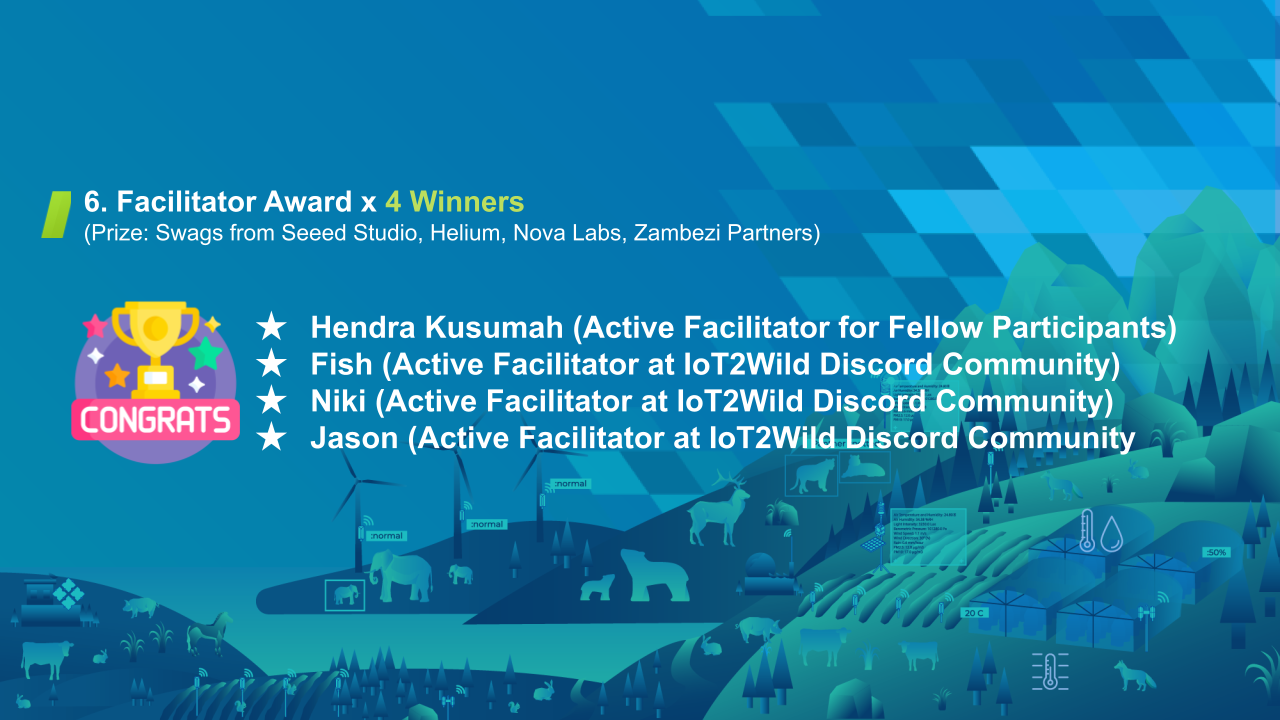
To conclude, congratulations to all the winners of this IoT2Wild Contest! In the coming weeks, our Seeed team will reach out to all the winners by email to arrange the prizes of each Award.
Last but not least, given the time limits at the Impact Summit, we’re planning to organize a follow-up Seeed webinar in October or November this year. There, the winners will be able to share what their projects are about, why and how they developed it, and what’s going to be their future plans on using #AIoT4SDGs. Stay tuned for webinar updates on Seeed’s LinkedIn, Discord, Twitter, Project Hub on Hackster, Facebook, and YouTube. Let’s keep this up – our pace for #SustainableMaking! Here we go again!
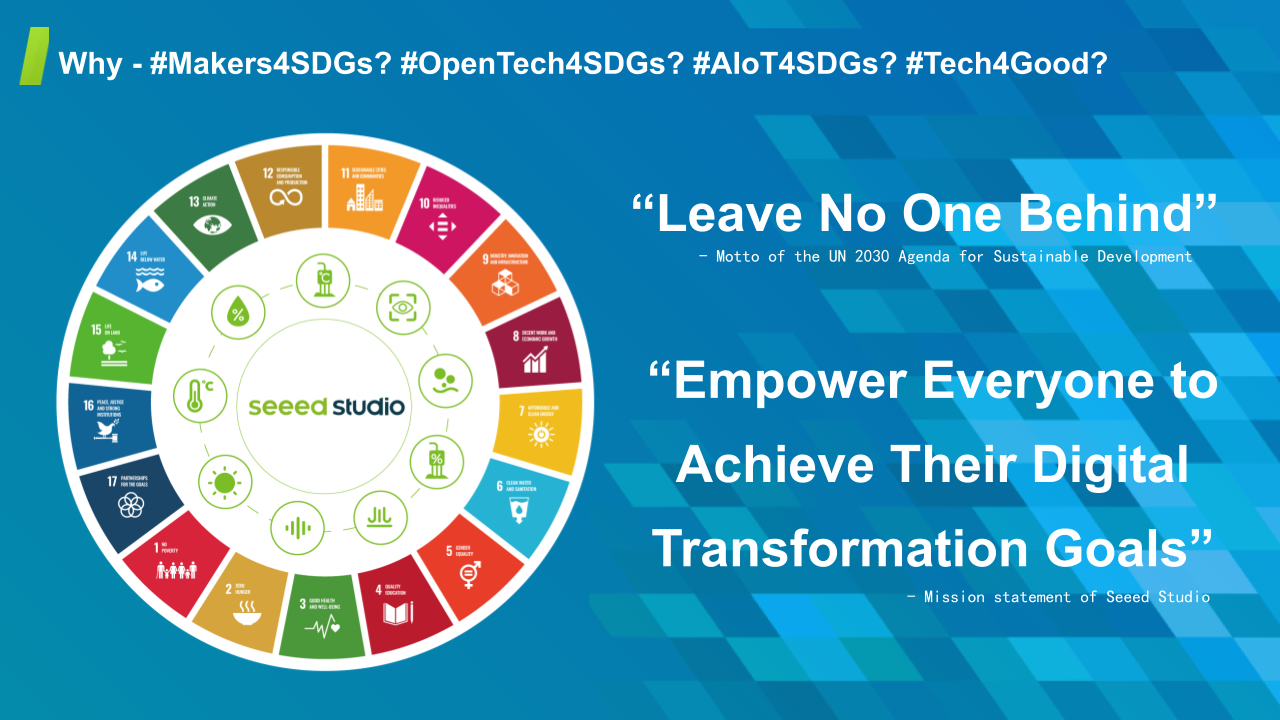


About Author
Ye Seong SHIN
Sustainability and CSR Manager at Seeed Studio
。
Jointly organize/participate in multi-stakeholder projects/platforms/events/webinars/workshops/hackathons/etc. to accelerate SDGs with local communities and open tech anywhere in the world by connecting with Ye Seong SHIN today on LinkedIn.
。
Seeed Studio is the IoT and AI solution provider for all types of traditional industries’ sustainable digitalization. Since its establishment in 2008, Seeed Studio’s technological products and customization services are used for smart agriculture, smart cities, smart environmental monitoring, smart animal farming, smart aquaculture, meteorological monitoring, STEAM education, and all types of emerging scenarios enabled by the Industry 4.0. With the company’s mission to “Empower Everyone to Achieve Their Digital Transformation Goals” (which shares similar values with SDGs’ Motto of “Leave No One Behind”), Seeed Studio is devoted to using open source technologies for accelerating SDGs with multi-stakeholders from UN agencies, academia, companies, CSOs, governments, public/private organizations, and so on. This is why, Seeed Studio also founded “Chaihuo Maker Space”, and started China’s first Maker Movement by annually organizing “Maker Faire Shenzhen”.
I’ve read a lot of articles, but yours has made the most lasting effect on me. The information you provided was incredibly helpful.
Dear Five Nights at Freddy’s, thank you very much for your kind comment, as well as your vote of confidence towards this article. Surely, the global open source community’s stories never stop to inspire people like us! I’ll try my best to spread out their voices on using #AIoT4SDGs, and hopefully, their voices can generate sustainable, positive, and self-empowering effects. Let’s keep the ball rolling! – Best, Ye Seong
– Best, Ye Seong